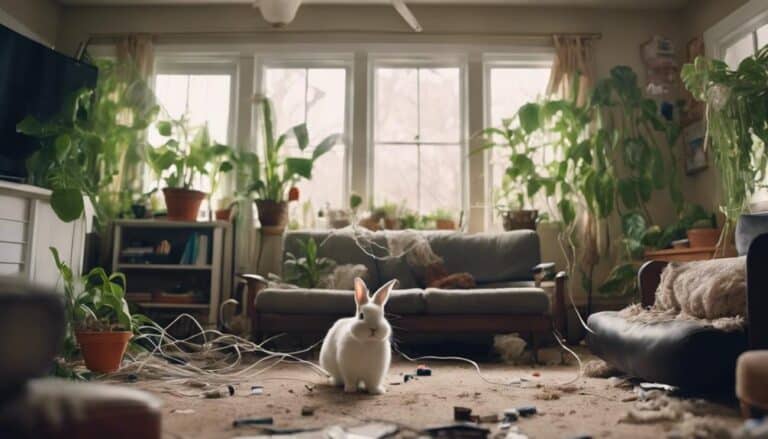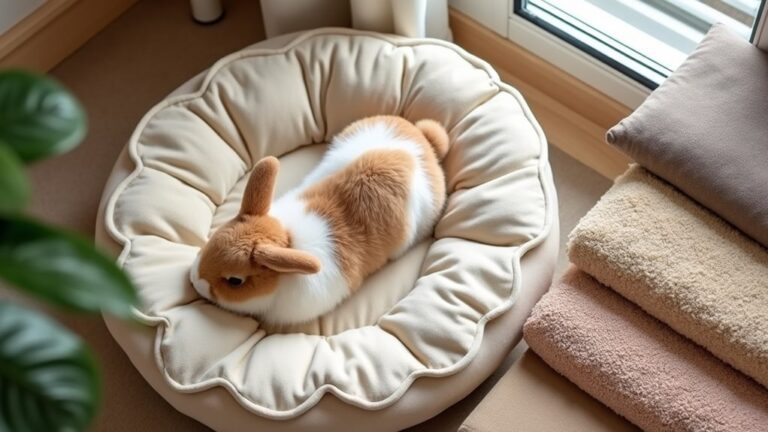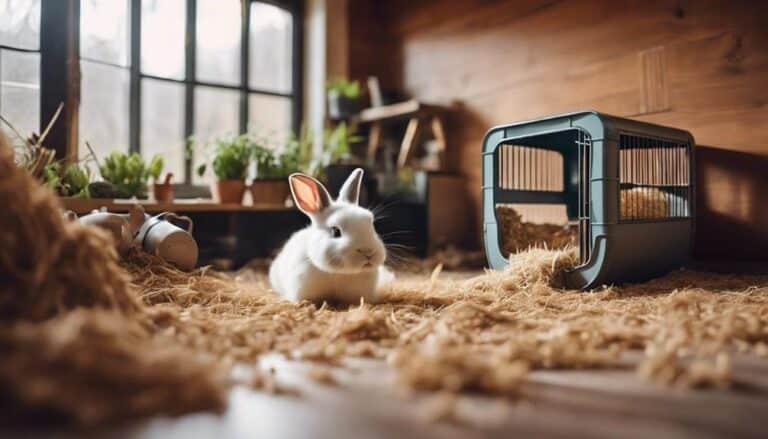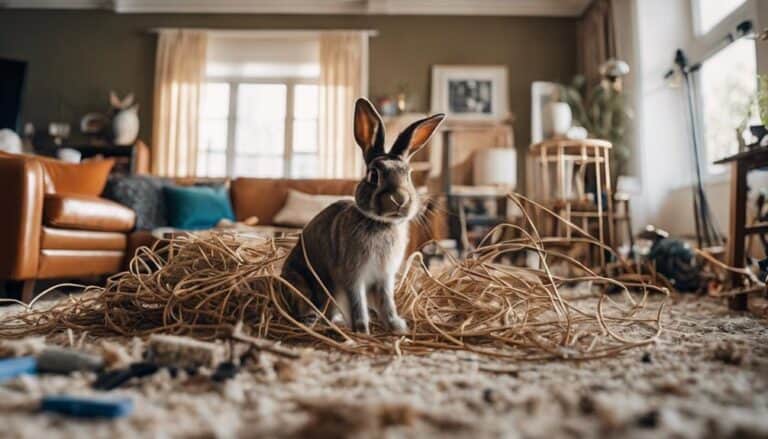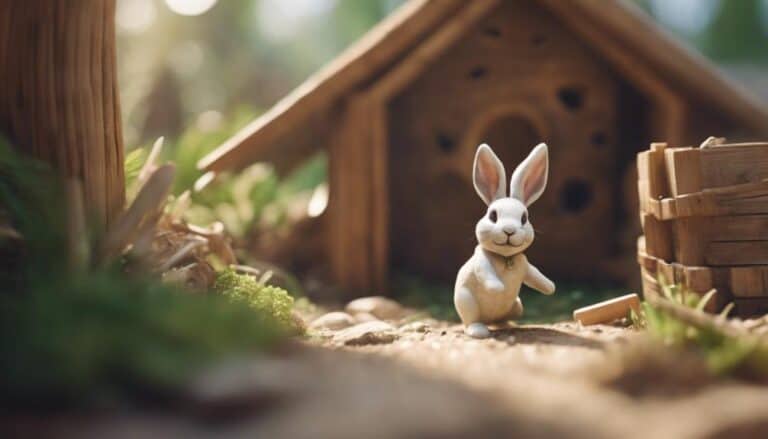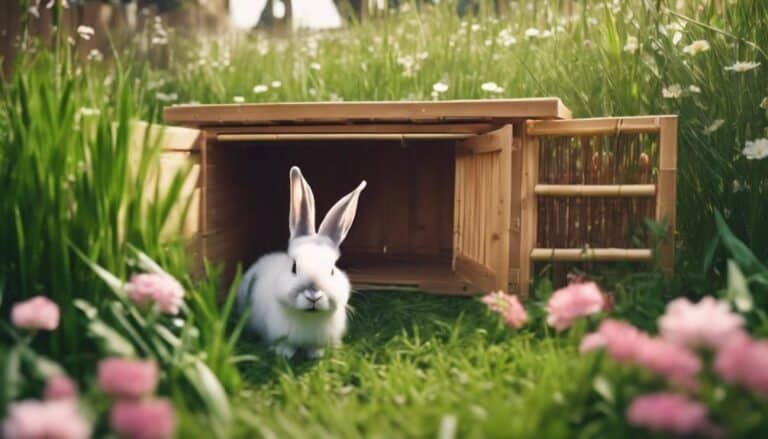Did you know that rabbits have a natural instinct to explore and need at least 32 square feet of space to thrive?
When it comes to setting up a safe bunny habitat, you may have numerous questions about the best practices to guarantee your bunny's well-being.
From choosing the right housing options to understanding the essential equipment needed, there are key factors to take into account in creating a secure and comfortable environment for your furry companion.
Curious to learn more about how to provide the best habitat for your bunny?
Contents
- 1 Key Takeaways
- 2 Bunny Housing Options
- 3 Indoor Vs. Outdoor Living
- 4 Essential Bunny Habitat Equipment
- 5 Ensuring Bunny Safety and Security
- 6 Maintaining Bunny Hygiene
- 7 Bunny Habitat Ventilation Needs
- 8 Protecting Bunnies From Hazards
- 9 Travel Tips for Bunnies
- 10 Frequently Asked Questions
- 11 What are Some Safety Tips for Creating a Rabbit-Friendly Habitat?
- 12 Conclusion
Key Takeaways
- Indoor and outdoor setups require safety, space, and amenities for a happy rabbit.
- Essential equipment like water bottles, food dishes, and hideouts ensure hydration and nutrition.
- Regular hygiene practices, health check-ups, and behavior observation maintain bunny well-being.
- Outdoor environments offer natural sunlight, secure spaces, and constant access to water and toys.
Bunny Housing Options

Wondering what housing options are best for your rabbit? When it comes to indoor setups, guarantee and comfort are key. For your indoor rabbit, consider creating a free-range environment that allows for gradual expansion as they get accustomed to litter training. Designate a specific room with flooring that's easy to clean and maintain proper temperature control for your bunny's well-being.
To guarantee your rabbit feels safe and comfortable, provide hiding spots, ramps, elevated areas, and soft bedding within their indoor habitat. These elements contribute to a secure and enriching living space for your furry friend. It's essential to use washable, flat, wide bowls for food and water, along with hay racks and one litter tray per rabbit for organized feeding and waste management in indoor setups.
Indoor Vs. Outdoor Living
When considering indoor versus outdoor living arrangements for your bunny, it's imperative to weigh the benefits of each. Indoor environments offer controlled temperature and protection from predators, while outdoor settings provide natural sunlight and fresh air.
Ensuring safety, adequate space, and proper amenities in both setups is essential for your rabbit's well-being.
Indoor Space Benefits
Indoor living for rabbits offers essential protection from predators and extreme weather conditions while providing a controlled environment for best comfort. In an indoor area, you can guarantee your rabbit has constant access to clean water, safe hiding spots, and appropriate chew toys.
This setting allows you to monitor their environment closely, ensuring they remain safe and secure at all times. By providing a designated indoor space for your rabbit, you can regulate the temperature to keep them comfortable throughout the year.
Creating a cozy and stimulating indoor habitat for your bunny won't only cater to their physical needs but also contribute to their overall well-being and happiness.
Outdoor Environment Considerations
Moving from the benefits of indoor living for rabbits, considering the outdoor environment is essential when creating a safe and stimulating habitat for your furry friend.
When setting up an outdoor environment for your rabbits, make sure to:
- Guarantee Security: Outdoor living setups should be secure, weatherproof, and spacious to allow rabbits to exercise and explore safely.
- Provide Exercise Runs: Attach exercise runs to outdoor housing, enabling rabbits to stretch and play without the risk of escaping.
- Offer Safe Hiding Places: Both indoor and outdoor environments should include secure hiding spots for rabbits to feel protected and secure.
These considerations are critical in maintaining a healthy and happy outdoor habitat for your rabbits.
Safety in Both
Have you considered the essential elements that guarantee the safety of both indoor and outdoor living environments for your rabbits?
When creating a safe habitat for your bunnies, it's important to provide a secure and comfortable space both indoors and outdoors. Indoor living offers protection from harsh weather conditions and potential predators, ensuring your rabbits' safety and well-being. It's important to include safe hiding spots, proper ventilation, and cozy accommodations within the indoor setup.
On the other hand, outdoor environments need to be weatherproof, secure, and escape-proof to prevent any harm to your rabbits. Whether indoors or outdoors, prioritize providing enough space and implementing safety measures to create a safe and enjoyable habitat for your furry friends.
Essential Bunny Habitat Equipment
To set up a safe and comfortable habitat for your bunny, it's important to have essential equipment in place. Items such as a water bottle, food dish, hay feeder, litter box, and a cozy hideout are fundamental for meeting your rabbit's basic needs.
These tools not only guarantee proper hydration, nutrition, waste management, and security but also contribute to creating a nurturing environment for your furry friend.
Habitat Must-Haves
When setting up a safe bunny habitat, make sure you have all the essential equipment, including a water bottle, feed bin, hay manger, litter box, and hanging items for enrichment and easy access.
Here are three must-haves for a well-equipped bunny habitat:
- Litter Box: Placing a litter box near the hay manger helps keep the habitat clean and odor-free.
- Winter Water Bottle: Opt for a water bottle with a heater during cold weather to guarantee your bunny has access to unfrozen water.
- Hanging Items: Hang toys, treats, or platforms within the habitat for your bunny's entertainment and easy access.
Safety Considerations
Ensuring your bunny habitat is equipped with secure hutch flooring is essential to prevent injuries and provide a safe environment for your furry friend. A secure hutch with solid flooring helps avoid accidents and promotes a comfortable living space.
Proper ventilation within the habitat is important for your bunny's health and overall well-being. Dual locks on the hutch offer added protection against predators, while a solid roof shields your pet from the elements. Constructing the hutch with durable materials like hardwood or metal can withstand your rabbit's natural gnawing behavior.
Additionally, including amenities such as a litter box, hay manger, water bottle, and hiding spots are important for creating a safe and cozy habitat for your beloved bunny.
Ensuring Bunny Safety and Security
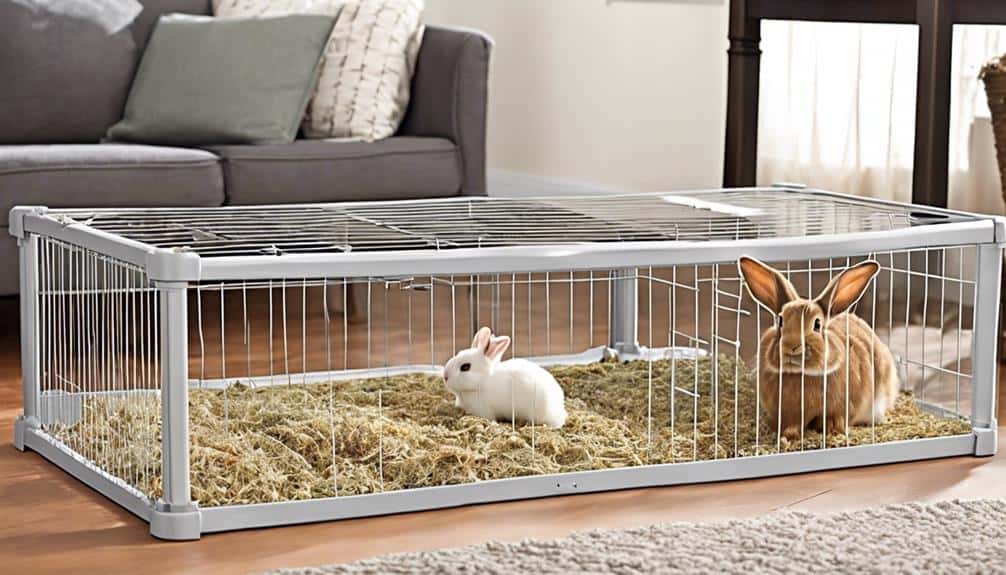
For ideal safety and security of your bunnies, prioritize using predator-proof materials like hardware cloth to secure outdoor enclosures. Position the bunny habitat away from direct sunlight to prevent overheating. Install dual locks on hutches to prevent predators from accessing the rabbits. Regularly inspect the habitat for any signs of wear or damage that could compromise safety. Create a safe environment by removing any toxic plants or substances that could harm the rabbits.
When setting up a safe bunny habitat, it's important to focus on the security and well-being of your furry friends. Here are three essential steps to bunny safety and security:
- Predator-Proof Enclosures: Utilize hardware cloth or similar sturdy materials to construct outdoor enclosures that can withstand potential predators' attempts to harm your rabbits.
- Heat Prevention: Keep your bunny habitat shaded and cool to prevent overheating, a common issue that can be dangerous for rabbits.
- Dual Locks on Hutches: Adding dual locks to your hutches adds an extra layer of security, preventing predators from gaining access to your rabbits and their safety at all times.
Maintaining Bunny Hygiene
To maintain top hygiene for your bunny, make sure that you clean its living area daily to prevent odor buildup and promote a healthy environment. Use rabbit-safe disinfectants when cleaning surfaces and removing any waste or soiled bedding. This will help prevent the spread of bacteria and keep your bunny's living space clean.
Additionally, regular nail trimming is vital to prevent overgrowth, which can cause discomfort and potentially lead to health issues. Grooming your bunny's fur is also essential to prevent matting and remove any debris or dirt that may have accumulated. Keeping your bunny clean and well-groomed not only guarantees their physical well-being but also helps you monitor their overall health.
Bunny Habitat Ventilation Needs
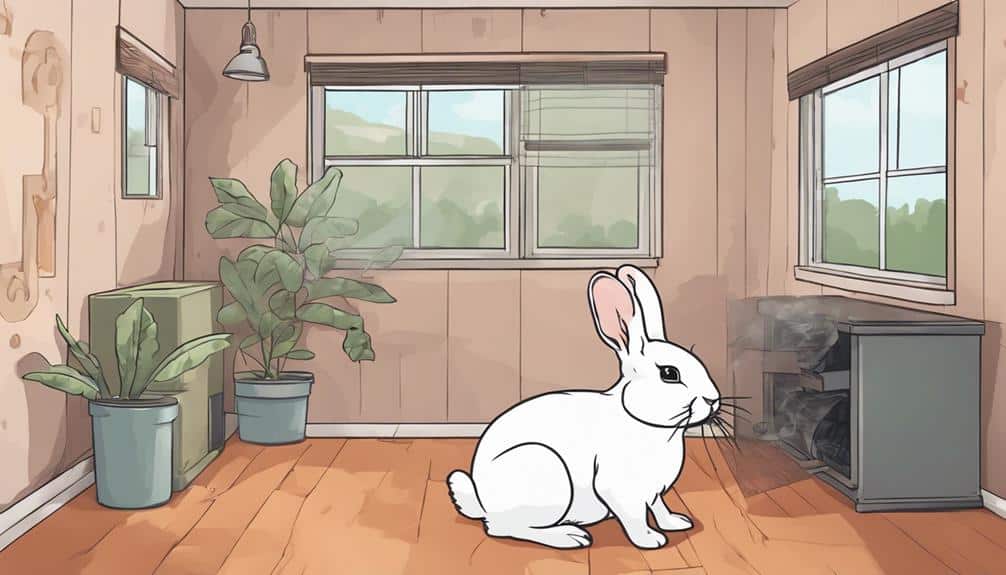
Guarantee ideal air circulation within your bunny habitat to safeguard your pet's respiratory health and overall well-being. Proper ventilation is essential to prevent respiratory issues and maintain good air quality for your bunny. Here are some key points to keep in mind:
- Preventing Respiratory Issues: Adequate ventilation helps in reducing the risk of respiratory problems in your bunny by ensuring fresh air circulation.
- Avoiding Heat Stress: Good ventilation assists in regulating the temperature within the habitat, preventing your bunny from experiencing heat stress during warmer periods.
- Maintaining Air Quality: Proper airflow helps in reducing humidity levels and preventing the buildup of harmful substances like ammonia from urine, ensuring a healthy living environment for your bunny.
Protecting Bunnies From Hazards
Protect your bunnies from potential hazards by creating a safe and secure environment free of dangerous objects or substances. Make sure that all electrical cords are out of reach to prevent chewing and potential electrocution. Keep toxic plants away from their living space and be cautious with other pets, especially Guinea Pigs, as interactions can sometimes lead to injuries.
When setting up their living area, avoid wire flooring or small grids that can harm their delicate paws. Choose a Rabbit Hutch with solid flooring and provide a comfortable layer of wood shavings for bedding. It's important to check for any potential escape routes or areas where bunnies could get stuck or injured.
Also, make sure they've access to fresh water at all times to stay hydrated. By being proactive and mindful of their surroundings, you can create a safe haven for your bunnies to thrive happily.
Travel Tips for Bunnies
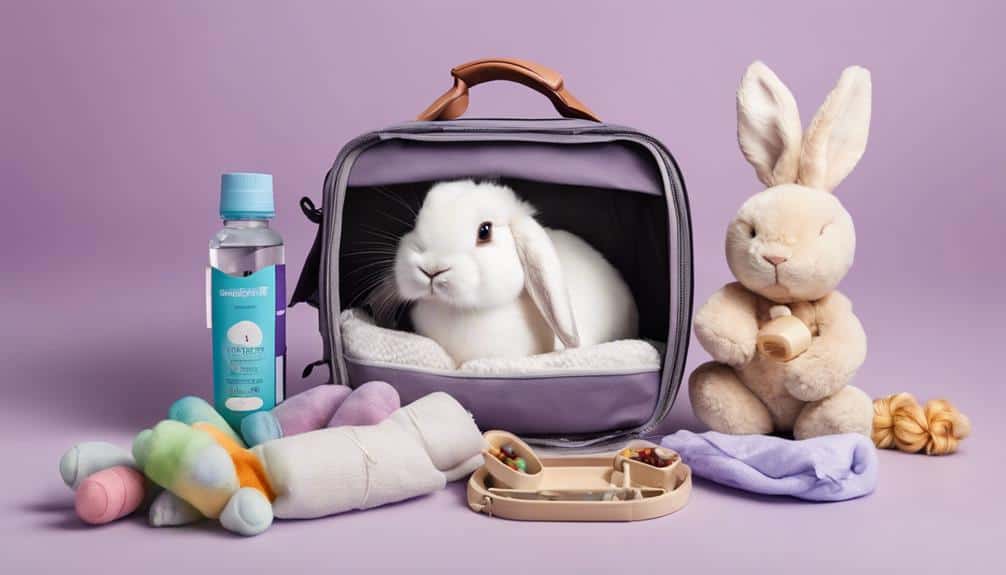
When traveling with your bunny, make sure you use a secure carrier with good ventilation to keep your furry companion safe and comfortable. Here are some travel tips to make certain a smooth journey for your bunny:
- Choose the Right Carrier: Select a carrier that's large enough for your rabbit to move comfortably but secure enough to prevent escapes. Make certain it has proper ventilation to keep the air flowing inside.
- Familiar Bedding: Place familiar bedding or hay in the carrier to provide your bunny with a sense of comfort and security during the journey. Familiar scents can help reduce stress.
- Hydration and Nutrition: Offer water and a small amount of familiar food during longer trips to keep your bunny hydrated and nourished. Avoid overfeeding to prevent any potential tummy issues while traveling.
Frequently Asked Questions
What Are Important Considerations in Rabbit Housing?
When considering rabbit housing, remember indoor vs outdoor options, space requirements, flooring choices, and the need for hideaway spots. A hutch should be spacious, safe, cozy, and mimic a natural environment for your bunnies' well-being.
What Does a Bunny Habitat Need?
For a bunny habitat, consider both indoor and outdoor options, ensuring adequate space for movement. Provide safe bedding materials, fresh water, and hay. Include hiding spots and enrichment activities to keep your bunny happy and healthy.
How Do You Set up a Rabbit Habitat?
For an indoor rabbit habitat, choose a spacious cage with room for movement. Opt for a pen if outdoor space is available. Make sure the enclosure meets size requirements and include enrichment options like tunnels and chew toys for stimulation.
What Does a Bunny Enclosure Need to Be?
For a bunny enclosure, whether indoors or outdoors, you need ample space, solid flooring, and enriching activities. Provide a 4x2x2 feet area, safe flooring, and items like a litter box and toys for a happy bunny.
What are Some Safety Tips for Creating a Rabbit-Friendly Habitat?
When creating a rabbit-friendly environment, there are several ways to create a rabbit-friendly environment. Firstly, provide a spacious enclosure with plenty of room to hop and play. Additionally, ensure the habitat is escape-proof and free from any potential hazards such as toxic plants or dangerous electrical cords.
Conclusion
Now that you have all the tools and knowledge to create a safe bunny habitat, remember that it's not just a shelter – it's a sanctuary for your furry friend.
Just like how a garden needs tender care to flourish, your bunny's habitat needs nurturing to thrive.
By tending to their needs with love and diligence, you're cultivating a haven where your bunny can blossom into their happiest, healthiest self.
Happy bunny-keeping!

